Content Marketing
Develop a Winning Content Marketing Strategy With Contently
Your content marketing strategy defines your core audience, the topics of conversation you want to engage in, and the goals and expectations of that conversation. An effective content marketing platform (CMP) provides a central and accessible location for all the documentation related to the strategy. This allows creatives to easily refer to the strategy and ensure their ideas and outputs are aligned, relevant, and on-brand.
Let’s dive into a few key content marketing strategy features your CMP should have to help you distribute it effectively across your content team and throughout the organization.
Goals
Defining clear, measurable goals is a cornerstone of a successful content strategy, providing focus, direction, and benchmarks for success. Yet, many marketers struggle to identify what successful content looks like. Contently provides prompts that help you define the primary goal, be it brand awareness or lead generation, which can help set the direction for the content strategy.

To ensure the strategy is tailored to the right audience, you can specify your organization type (B2C or B2B), which informs the type of content and messaging that will be most effective. You also have space to outline your content mission, which will ensure you’re creating content that aligns with your brand’s values and objectives.
In terms of measuring success, Contently provides a variety of KPIs that brands can select based on their unique goals and needs. This could include metrics like total people reached, total attention time, engagement rate, finish rate, and returning visitors, among others. These KPIs go beyond superficial metrics like page views and likes, enabling brands to track meaningful engagement and the true impact of their content.
Finally, you can choose to attach additional materials, like visual guidelines or brand style guides, to ensure that all content aligns with the brand’s visual identity and tone of voice.
Audiences
Establishing well-defined audiences, or personas, is a critical part of your content marketing strategy. This crucial process involves detailing specific characteristics of your target audience, such as job title or role, age or career stage, education level, gender, and the topics or issues they care about.
Incorporating relevant market research and user profiles into your strategy documentation can help provide a more comprehensive and accurate picture of your audience. Has your product team done any interviews with market leaders or user research? These insights are vital for audience or persona development.
Understanding your audience is fundamental to creating content that is not only relevant but also engaging and impactful. By having a clear understanding of who your audiences are, their interests, behaviors, and preferences, you can ensure that your content aligns with their needs and expectations, making it more likely to resonate with them.
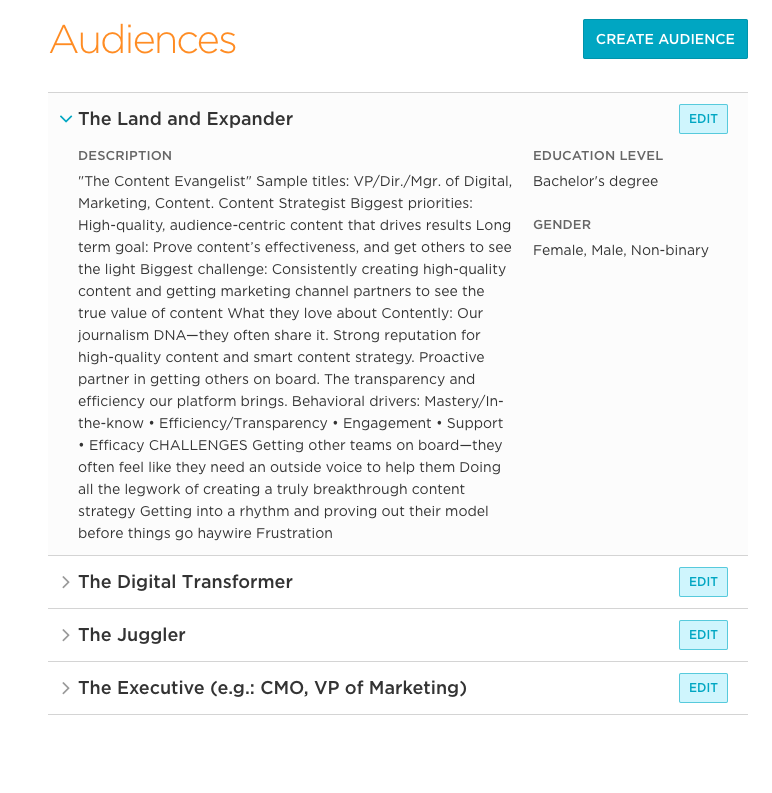
Contently allows you to incorporate this audience data into your content marketing strategy. It enables you to document and organize your audience personas, providing a constant reference point for all content creation efforts. This audience-centric approach helps ensure that every piece of content you create has a specific purpose and target, leading to more personalized and effective content.
Plus, having this audience information centralized within Contently’s platform provides an accessible, shared understanding of the target audience for everyone involved in the content creation process. Your personas are attached to each project you create, enabling you to train new writers with ease and provide a consistent reference point for current teammates. This shared understanding helps align your team’s efforts, ensuring consistency across all content and reinforcing your brand’s identity and message. By placing your audience at the heart of your content strategy, Contently empowers you to create content that is not only engaging but also successful in driving your desired results.
Pillars
Content teams often refer to the main topics they’ll focus on for a given year as “pillars.” The CMP should include descriptions of your pillar topics, as well as related in-house and third-party resources that can help copywriters and editors get quickly up to speed on key pillar-related issues the audience cares about.

Contently enables users to create and manage pillar descriptions and links to published content related to the pillar. This provides four main benefits:
Speeds Up Onboarding
When new contributors join the team, whether they are in-house staff or freelancers, they can quickly get up to speed on the topics your audience cares about.
Ensures Consistency
Having clearly defined content pillars helps maintain consistency across all content. This is crucial for building brand identity and ensuring the audience receives a consistent message regardless of the content format or channel.
Facilitates Strategic Pitches
When soliciting content ideas from contributors, having established content pillars can guide them to be more strategic with their pitches. They can craft ideas that directly address the core topics of interest to the audience, thereby increasing the relevance and impact of the content.
Enhances SEO
Content pillars also play a significant role in search engine optimization (SEO). By consistently producing content around specific topics, brands can increase their chances of ranking higher on search engine results pages for related keywords.
Contently’s pillar-focused approach not only enhances content strategy but also streamlines content creation, ensuring all content is relevant, strategic, and impactful.
SEO Keywords
SEO keywords are the foundation of content engagement. Targeting the pillar-aligned keywords your audience searches for helps you make strategic decisions about when to focus on organic traffic and when to pay for search ad placement to get your content in front of the right people.
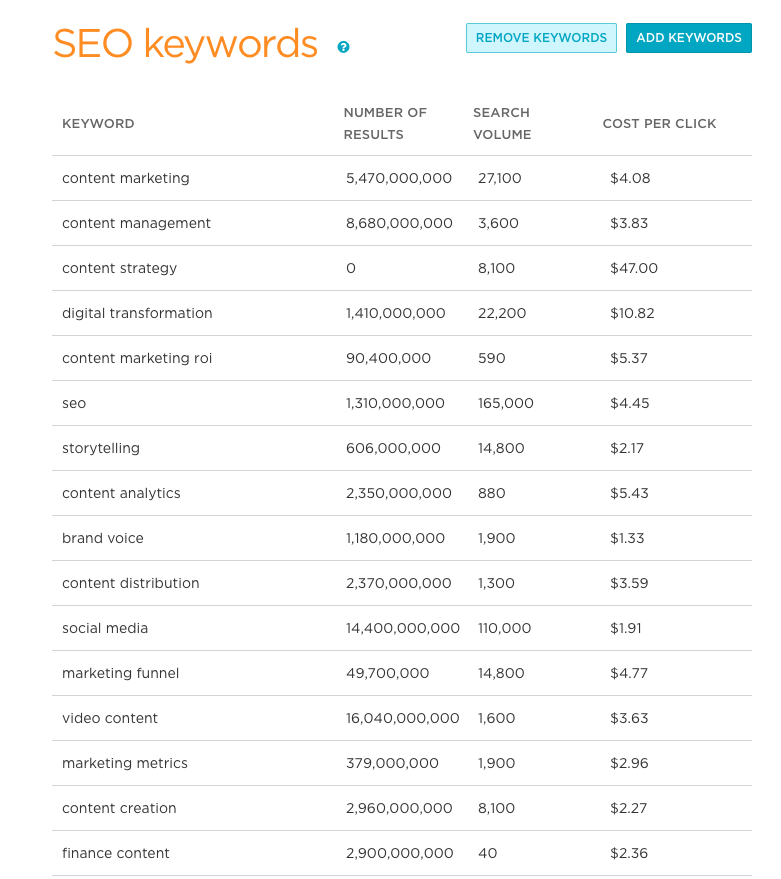
The SEO Keywords section within your content strategy plays a vital role in guiding content creation and ensuring that content aligns with audience interests and search behaviors.
- Teamwide Access: Once the keywords are entered into the platform, they become accessible to the entire content team. This ensures everyone is working with the same set of keywords, promoting consistency and alignment in content creation.
- Integration With Pillars and Stories: The added keywords can be used when creating pillars or new stories. This ensures that the core topics and narratives produced are optimized for the specific keywords that the audience is searching for.
- Keyword Data: When entering a keyword, Contently provides valuable data that you can use to assess the keyword’s competitiveness on search engine results pages. This data includes:
- Search Volume: The number of times users searched Google for the keyword or phrase in a given period.
- Number of Results: The number of pages that Google has indexed for the keyword or phrases.
- Cost Per Click (CPC): The amount an advertiser would pay to Google if a user clicked on their ad targeting the keyword or phrase.
- SEO Story Ideas: The SEO Keywords feature also powers the SEO Story Ideas function. The platform’s algorithm uses the target keywords and phrases to recommend topic ideas to the content team, providing a source of inspiration and direction for content creation. A minimum of 10 keywords is recommended to generate a variety of ideas.
The SEO Keywords section is not only a tool for keyword management but also a strategic resource for content creation, SEO optimization, and audience engagement planning.
Content Request Forms
Content teams often receive projects to support other departments within their organizations. Without an effective way to manage and streamline requests, marketers can find it difficult to gather all the needed information.
That’s why Contently has a Content Requests option that empowers teams across your organization to request assets. This tool is particularly useful for content users such as sales teams, customer teams, or marketing operations teams who may need specific content.
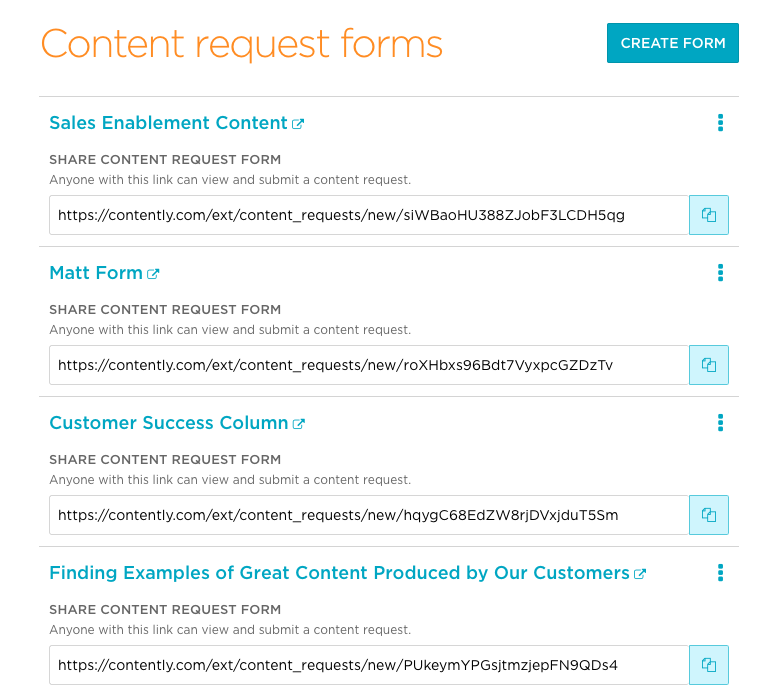
The forms include standard fields for the requestor’s details and specifics about the content needed, such as a description, due date, and an option to upload a file. It also has optional fields for targeting a specific audience or aligning with a content pillar, both derived from the publication’s content strategy. This not only helps centralize the content request process but also sends automated progress and deadline updates, resulting in efficient management.
Beyond centralizing the content request process and improving efficiency, Contently’s Content Requests option also aids in the prioritization of projects. It allows content teams to effectively balance their own initiatives with incoming requests from other departments.
By aligning each request with the established content strategy and considering the current content queue, teams can make informed decisions on the priority and feasibility of each project. This helps ensure that both immediate company needs and long-term content goals are addressed, contributing to a harmonious and productive content environment. Ultimately, this feature promotes a more strategic approach to content creation and management, fostering a balance between serving internal needs and advancing the overarching content strategy.
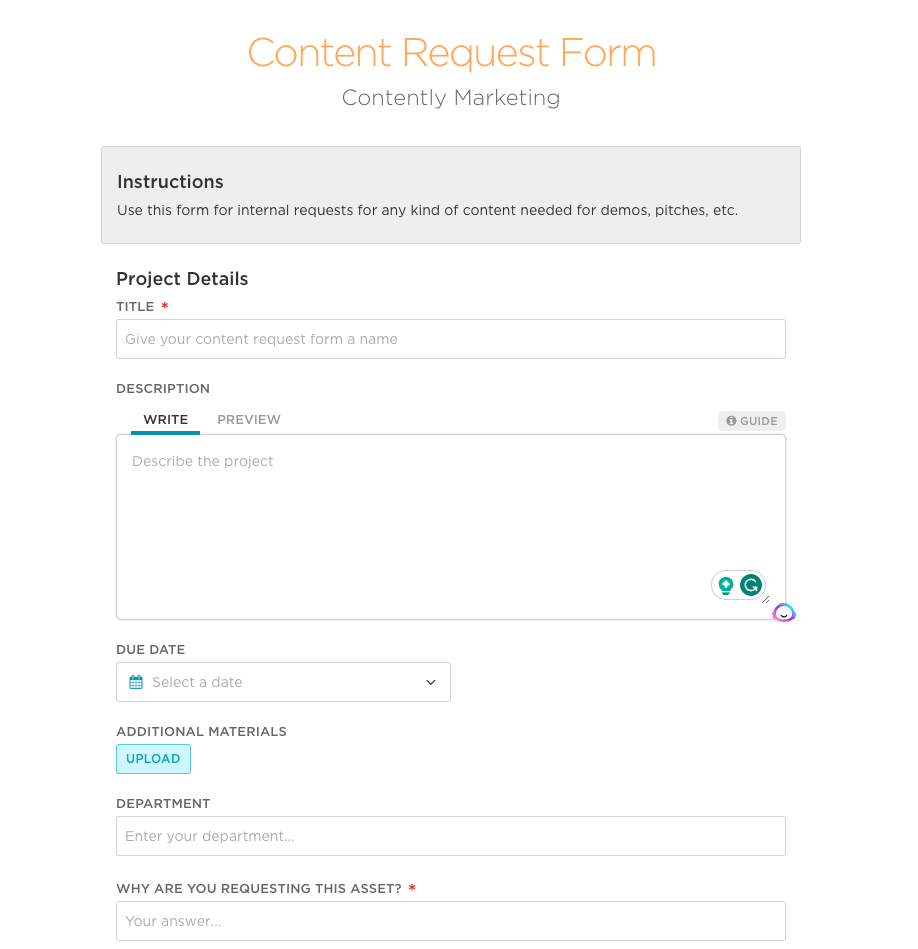
Content Plan
As Antoine de Saint-Exupéry said, “A goal without a plan is just a wish.” And that’s definitely the case with your content strategy. Now that you have your audiences, goals, and pillars set up, it’s time to pull it all together and create your content plans.
The Content Plan feature allows users to create individual buckets for each content initiative. They can be aligned to each core pillar, specific campaigns, or goals such as lead generation, brand awareness, and sales enablement. For each plan, you can specify content formats, sub-formats, quantities, publishing frequency, and the budget allocated for creation. This ensures every piece of content serves a strategic purpose, contributing towards the overarching business objectives.
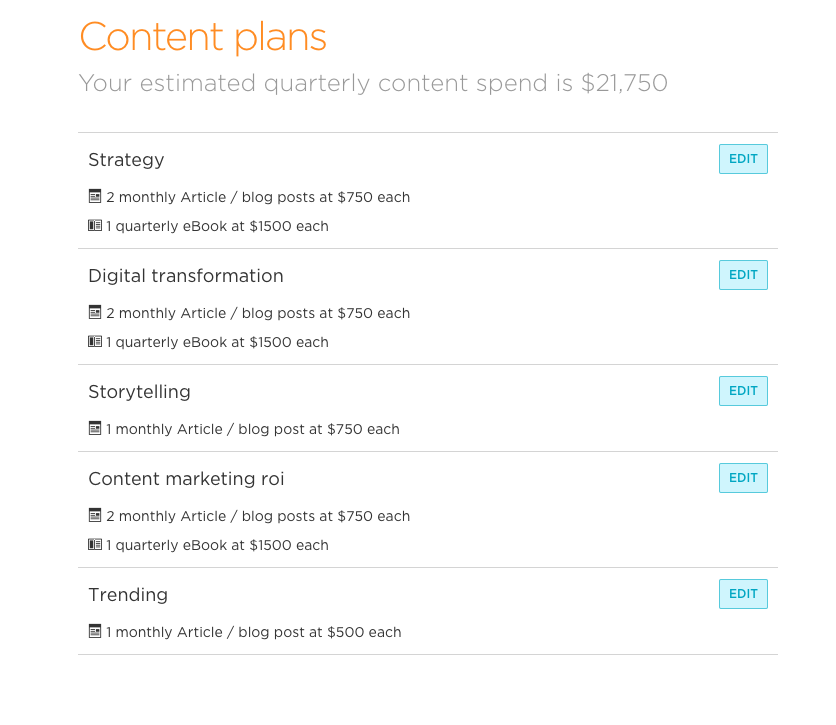
By individually aligning each plan to specific goals or campaigns, the Content Plan provides a clear roadmap of content initiatives that cater to various audience segments and business needs. Assigning a specific budget to each plan offers greater financial transparency and streamlines budget management.
Once you’ve set up your content plans, you can then use them to populate your editorial calendar. This systematic approach ensures consistency in content creation and distribution, contributing to better content management, team coordination, and enhanced audience engagement.
Workflow Templates
Document the processes and workflow teams for different content types. This ensures accountability about who is responsible for what and establishes clear hand-offs from one step to the next.
Contently’s workflow templates are a powerful tool that helps brands streamline their content production process. Users can delineate specific content creation stages, including production, review, and approval, and assign these responsibilities to the appropriate team members. By defining these workflows, teams can ensure every piece of content is effectively managed and overseen throughout its lifecycle, enhancing overall content quality and consistency.
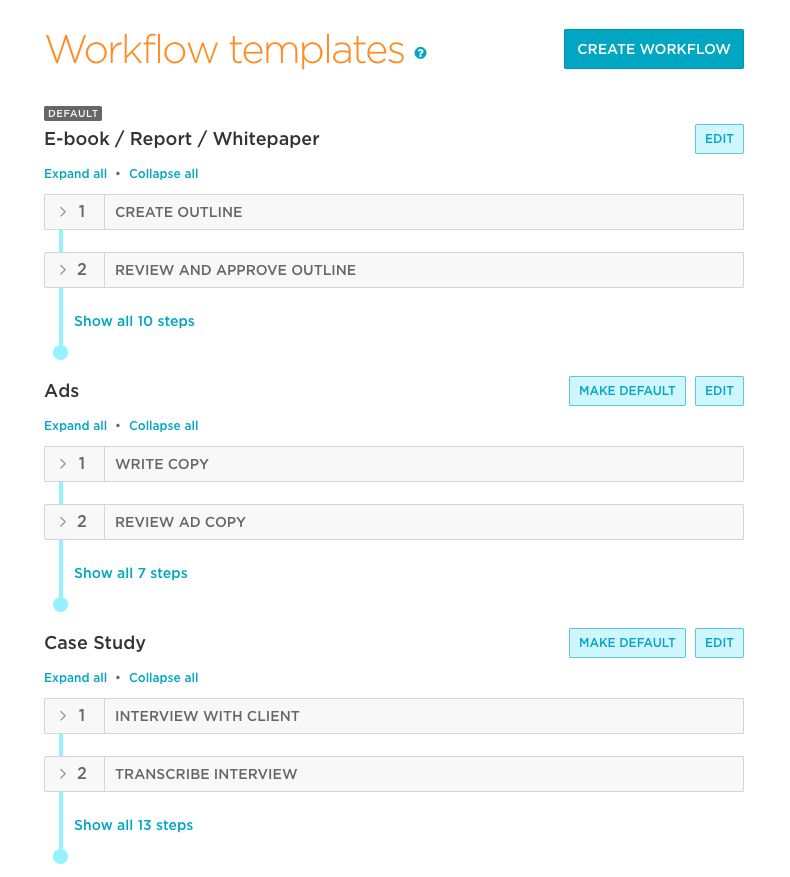
One of the main advantages of these templates is the flexibility they offer. Each workflow can be customized for every story, ensuring it fits the unique requirements of the piece. This can include stages like content optimization, graphic creation, and even distribution. Plus, these templates can be adjusted on a story-by-story basis without altering the original template, providing adaptability while preserving the established workflow structure.
At Contently, we also understand the need for flexibility in an increasingly collaborative business environment, where key contributors or stakeholders may not use the platform. To accommodate this, the platform allows you to include off-platform steps that let you add a collaborator’s email address so they can review the piece directly on the platform. The individual receives an email with a link to review the content when their input is required, and their feedback is integrated back into the platform. This ensures the content creation and approval process remains smooth and efficient, bridging the gap between internal and external team members.
Being able to assign either individual team members or entire teams to certain workflow stages improves collaboration and efficiency. This ensures that you involve the right people at the right time, and facilitates clear transitions between each process step. The system also maintains a comprehensive paper trail, promoting accountability and offering complete visibility into who has seen and approved each piece of content.
Enhance Your Content Marketing Strategy With Contently
Contently’s content marketing platform (CMP) is a comprehensive tool that streamlines the creation of effective content marketing strategies. It helps marketers define clear audiences, set measurable goals, focus on key topics, manage SEO, and handle content requests.
With its customizable content plans and workflow templates, Contently enhances team collaboration and ensures consistency across all content. The platform also facilitates engagement with external team members through off-platform steps. Overall, Contently’s CMP empowers content teams to create impactful content that resonates with their target audiences and drives desired results.
Learn more about Contently’s content marketing platform today. Schedule a discovery call with us today.
Image by storyset
Get better at your job right now.
Read our monthly newsletter to master content marketing. It’s made for marketers, creators, and everyone in between.




